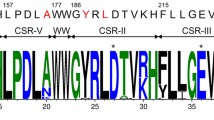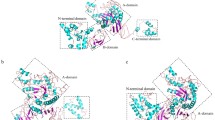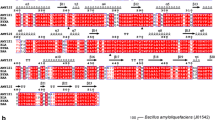Abstract
The functional and structural significance of glutamic acid 219 of a N- and C-terminally truncated Bacillus sp. strain TS-23 α-amylase (BACΔNC) was explored by the approach of site-directed saturation mutagenesis. The expressed wild-type and mutant enzymes have been purified by nickel-chelate chromatography and their molecular mass was determined to be approximately 54 kDa by SDS/PAGE. Except E219F, E219P, and E219W, all other mutant enzymes exhibited a lower shift in their optimum temperatures with respect to the wild-type enzyme. A decreased thermostability was also found in all of the mutant enzymes when compared with the wild-type form of BACΔNC. Except E219F, E219P, and E219W mutant enzymes, greater than 2-fold decrease in k cat and a similar substrate affinity relative to the wild-type BACΔNC were observed for the rest mutant enzymes. Based on these observations, it is suggested that Glu-219 apparently plays an important role in the thermostability of BACΔNC.




Similar content being viewed by others
References
Adams MW (1993) Enzymes and proteins from organisms that grow near and above 100°C. Annu Rev Microbiol 47:627–658
Aghajari N, Feller G, Gerday C, Haser R (1998) Structures of the psychrophilic Alteromonas haloplantics α-amylase give insights into cold adaptation at a molecular level. Structure 6:1503–1516
Anderson DE, Hurley JH, Nicholson H, Baase WA, Matthews BW (1993) Hydrophobic core repacking and aromatic-aromatic interaction in the thermostable mutant of T4 lysozyme Ser 117→Phe. Protein Sci 2:1285–1290
Ben Ali M, Khemakhem B, Robert X, Haser R, Bejar S (2006) Thermostability enhancement and change in starch hydrolysis profile of the maltohexaose-forming amylase of Bacillus stearothermophilus US100 strain. Biochem J 394:51–56
Bhuiya MW, Sakuraba H, Ohshima T, Imagawa T, Katunuma N, Tsuge H (2005) The first crystal structure of hyperthermostable NAD-dependent glutamate dehydrogenase from Pyrobaculum islandicum. J Mol Biol 345:325–337
Brosnan MP, Kelly CT, Fogarty WM (1992) Investigation of the mechanisms of irreversible thermoinactivation of Bacillus stearothermophilus α-amylase. Eur J Biochem 203:225–231
Chan MK, Mukund S, Kletzin A, Adams MW, Rees DC (1995) Structure of a hyperthermophilic tungstopterin enzyme, aldehyde ferredoxin oxidoreductase. Science 267:1463–1469
Chang CT, Lo HF, Chi MC, Yao CY, Hsu WH, Lin LL (2003) Identification of essential histidine residues in a recombinant α-amylase of thermophilic and alkaliphilic Bacillus sp. strain TS-23. Extremophiles 7:505–509
Cheung YY, Lam SY, Chu WK, Allen MD, Bycroft M, Wong KB (2005) Crystal structure of a hyperthermophilic archaeal acylphosphatase from Pyrococcus horikoshii: structural insights into enzymatic catalysis, thermostability, and dimerization. Biochemitry 44:4601–4611
D’Amico S, Gerday C, Feller G (2002) Structural determinants of cold adaptation and stability in a psychrophilic α-amylase. Biologia (Bratislava) 57:211–219
D’Amico S, Marx JC, Gerdy C, Feller G (2003) Activity stability relationships in extremophilic enzymes. J Biol Chem 278:7891–7896
Daniel RM, Danson MJ (2001) Assaying activity and assessing thermostability of hyperthermophilic enzymes. Methods Enzymol 334:283–393
Declerck N, Machius M, Chambert R, Wiegand G, Huber R, Gaillardin C (1997) Hyperthermostable mutants of Bacillus licheniformis α-amylase: thermodynamic studies and structural interpretation. Protein Eng 10:541–549
Declerck N, Machius M, Weigand G, Huber R, Gaillardin C (2000) Probing structural determinants specifying high thermostability in Bacillus licheniformis α-amylase. J Mol Biol 301:1041–1057
Declerck N, Machius M, Joyet P, Wiegand G, Huber R, Gaillardin C (2002) Engineering the thermostability of Bacillus licheniformis α-amylase. Biologia (Bratislava) 57:203–211
Declerck N, Machius M, Joyet P, Wiegand G, Huber R, Gaillardin C (2003) Hyperthermostabilization of Bacillus licheniformis α-amylase and modulation of its stability over a 50°C temperature range. Protein Eng 16:287–293
Feller G, Payan F, Theys F, Qian M, Haser R, Gerday C (1994) Stability and structural analysis of α-amylase from the antarctic psychrophile Alteromonas haloplanctis A23. Eur J Biochem 222:441–447
Fitter J (2005) Structural and dynamical features contributing to thermostability in α-amylases. Cell Mol Life Sci 62:1925–1937
Fitter J, Herrmann R, Dencher NA, Blume A, Hauss T (2001) Activity and stability of a thermostable α-amylase compared to its mesophilic homologue: mechanism of thermal adaptation. Biochemistry 40:10723–10731
Hurley JH, Baase WA, Matthews BW (1992) Design and structural analysis of alternative hydrophobic core packing arrangements in bacteriophage T4 lysozyme. J Mol Biol 224:1143–1159
Janeček Š (1993) Does the increased hydrophobicity of the interior and the hydrophilicity of the exterior of an enzyme structure reflect its increased thermostability? Int J Biol Macromol 15:317–318
Janeček Š (1997) alpha-Amylase family: molecular biology and evolution. Prog Biophys Mol Biol 67:67–97
Janeček Š, Balaz S (1992) α-Amylases and approaches leading to their enhanced stability. FEBS Lett 304:1–3
Janeček Š, Leveque E, Belarbi A, Haye B (1999) Close evolutionary relatedness of α-amylases from Archaea and plants. J Mol Evol 48:421–426
Kanai R, Haga K, Akiba T, Yamane K, Harata K (2004) Biochemical and crystallographic analyses of maltohexaose-producing amylase from alkalophilic Bacillus sp. 707. Biochemistry 43:14047–14056
Karshikoff A, Ladenstein R (2001) Ion pairs and the thermotolerance of proteins from hyperthermophiles: a ‘traffic rule’ for hot roads. Trends Biochem Sci 26:550–556
Karlstrom M, Stokke R, Steen IH, Birkeland NK, Ladenstein R (2005) Isocitrate dehydrogenase from the hyperthermophile Aeropyrum pernix: X-ray structure analysis of a ternary enzyme-substrate complex and thermal stability. J Mol Biol 345:559–577
Kim YW, Choi JH, Kim JW, Park C, Cha HJ, Oh BH, Moon TW, Park KH (2003) Directed evolution of Thermus maltogenic amylase toward enhanced thermal resistance. Appl Environ Microbiol 69:4866–4874
Korolev S, Nayal M, Barnes WM, Di Cera E, Waksman G (1995) Crystal structure of the large fragment of Thermus aquaticus DNA polymerase I at 2.5-Å resolution: structural basis for thermostability. Proc Natl Acad Sci USA 92:9264–9268
Lin LL, Chen PJ, Liu JS, Wang WC, Lo HF (2006) Idetification of glutamate residues important for catalytic activity or thermostability of a truncated Bacillus sp. strain TS-23 α-amylase by site-directed mutagenesis. Protein J 25:232–239
Lin LL, Tasu MR, Chu WS (1997) A gene encoding for an α-amylase from thermophilic Bacillus sp. strain TS-23 and its expression in Escherichia coli. J Appl Microbiol 82:325–334
Lo HF, Chen YH, Hsiao NW, Chen HL, Hu HY, Hsu WH, Lin LL (2005) Stabilization of a truncated Bacillus sp. strain TS-23 α-amylase by replacing histidine 436 with aspartate. World J Microbiol Biotechnol 21:411–416
Lo HF, Lin LL, Chiang WY, Chi MC, Hsu WH, Chang CT (2002) Deletion analysis of the C-terminal region of the α-amylase of Bacillus sp. strain TS-23. Arch Microbiol 178:115–123
Lo HF, Lin LL, Li CC, Hsu WH, Chang CT (2001) The N-terminal signal sequence and the last 98 amino acids are not essential for the secretion of Bacillus sp. TS-23 α-amylase in Escherichia coli. Curr Microbiol 43:170–175
MacGregor EA, Janeček Š, Svensson B (2001) Relationship of sequence and structure to specificity in the α-amylase family of enzymes. Biochim Biophys Acta 1546:1–20
Machius M, Declerck N, Huber R, Wiegand G (1998) Activation of Bacillus licheniformis α-amylase through disorder→order transition of the substrate-binding site mediated by a calcium-sodium-calcium metal triad. Structure 6:281–292
Machius M, Declerck N, Huber R, Wiegand G (2003) Kinetic stabilization of Bacillus licheniformis α-amylase through introduction of hydrophobic residues at the surface. J Biol Chem 264:18933–18938
Matsuura Y, Kusunoki M, Harada W, Kakudo M (1984) Structure and possible catalytic residues of Taka-amylase A. J Biochem (Tokyo) 95:697–702
Miller GL (1959) Use of dinitrosalicyclic acid reagent for determination of reducing sugars. Anal Chem 31:426–428
Miyazono K, Sawano Y, Tanokura M (2005) Crystal structure and structural stability of acylphosphatase from hyperthermophilic archaeon Pyrococcus horikoshii OT3. Proteins 61:196–205
Morand P, Biellmann JF (1991) Modification of α-amylase from Bacillus licheniformis by the polyaldehyde derived from β-cyclodextrin and α-amylase thermostability. FEBS Lett 289:148–150
Nielsen JE, Borchert TV (2000) Protein engineering of bacterial α-amylases. Biochim Biophys Acta 1543:253–274
Russell RJ, Hough DW, Danson MJ, Taylor GL (1994) The crystal structure of citrate synthase from the thermophilic archaeon, Thermoplasma acidophilum. Structure 2:1157–1167
Sambrook J, Russell DW (2001) Molecular cloning: a laboratory manual, 3rd edn. Cold Springer Harbor Laboratory, Cold Spring Harbor, New York, USA
Schumann J, Bohm G, Schumacher G, Rudolph R, Jaenicke R (1993) Stabilization of creatinase from Pseudomonas putida by random mutagenesis. Protein Sci 10:1612–1620
Spassov VZ, Karshikoff A, Ladenstein R (1995) The optimization of protein-solvent interactions: thermostability and the role of hydrophobic and electrostatic interactions. Protein Sci 4:1516–1527
Stam MR, Danchin EGJ, Rancurel C, Coutinho PM, Henrissat B (2006) Dividing the large glycoside hydrolase family 13 into subfamilies: towards improved functional annotations of α-amylase-related proteins. Protein Eng Des Sel 19:555–562
Suvd D, Fujimoto Z, Takase K, Matsummra M, Mizuno H (2001) Crystal structure of Bacillus stearothermophilus α-amylase: possible factors determining the thermostability. J Biochem (Tokyo) 129:461–468
Suzuki Y, Ito N, Yuuki T, Yamagata H, Udaka S (1989) Amino acid residues stabilizing a Bacillus α-amylase against irreversible thermoinactivation. J Biol Chem 264:18933–18938
Synowiecki J, Grzybowska B, Zdziebio A (2006) Sources, properties and suitability of new thermostable enzymes in food processing. Crit Rev Food Sci Nutr 46:197–205
Tanner JJ, Hecht RM, Krause KL (1996) Determinants of enzyme thermostability observed in the molecular structure of Thermus aquaticus D-glyceraldehyde-3-phosphate dehydrogenase at 25-Å resolution. Biochemistry 35:2597–2609
Tomazic SJ, Klibanov A (1988) Why is one Bacillus α-amylase more resistant against irreversible thermoinactivation than another? Biol Chem 263:3092–3096
Vihinen M, Mäntsälä P (1989) Microbial amylolytic enzymes. Crit Rev Biochem Biol 24:329–418
Violet M, Meunier JC (1989) Kinetic studies of the irreversible thermal inactivation of Bacillus licheniformis α-amylase. Biochem J 263:665–670
Acknowledgments
We are grateful to Dr. Julio Polaina for the assistance on the molecular model of BACΔNC and the valuable suggestions. This work was supported by a research grant (NSC95-2313-B-241-003) from National Science Council of Taiwan, Republic of China.
Author information
Authors and Affiliations
Corresponding author
Rights and permissions
About this article
Cite this article
Lin, LL., Liu, JS., Wang, WC. et al. Glutamic acid 219 is critical for the thermostability of a truncated α-amylase from alkaliphilic and thermophilic Bacillus sp. strain TS-23. World J Microbiol Biotechnol 24, 619–626 (2008). https://doi.org/10.1007/s11274-007-9518-0
Received:
Accepted:
Published:
Issue Date:
DOI: https://doi.org/10.1007/s11274-007-9518-0




